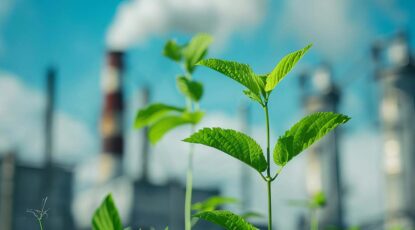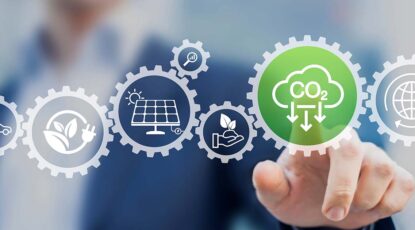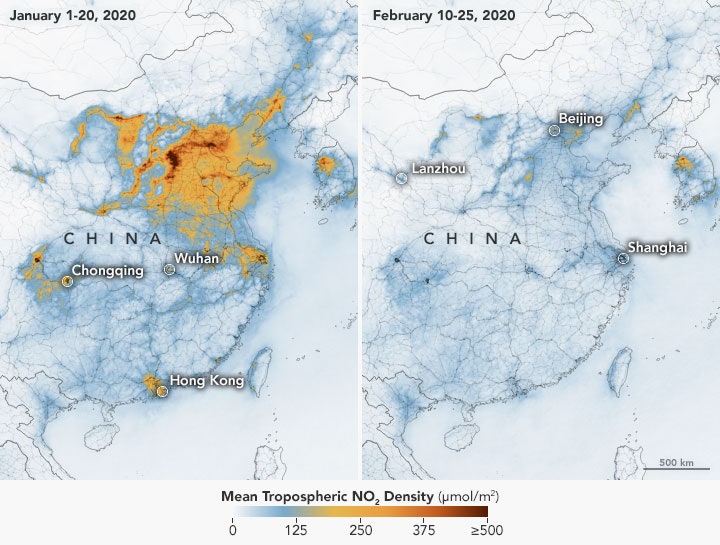
Satellite imagery shows a significant drop in NO2 levels in China since the onset of the COVID-19 outbreak. Courtesy of European Space Agency
Satellite imagery from the European Space Agency (ESA) paints a new, quite unfamiliar, picture of our skies – a strikingly clear one.
Since the COVID-19 pandemic has swept the globe, shutting down economies and impacting the lives of millions, we’ve witnessed one markedly positive consequence: less smog.
In industrial clusters across the world, readings from ESA’s Sentinel-5p satellite illustrate significantly reduced levels of nitrogen dioxide (NO2), a gaseous air pollutant in the nitrogen oxide (NOx) family and a major contributor to the formation of ozone, also known as smog.
In fact, according to NASA, NO2 levels across eastern and central China have been measured 10-30 percent lower than normal. And since Italy went into lockdown on March 9th, NO2 levels in Milan and other parts of northern Italy have fallen by about 40 percent.
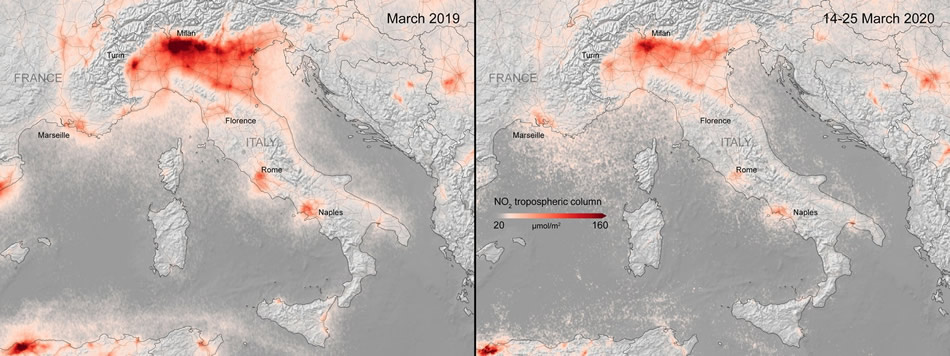
Levels of the smog-forming pollutant NO2 fell dramatically during the COVID-19 lockdown in Italy. Courtesy of European Space Agency
These trends are being mirrored around the world. New Delhi, India, for example, recorded a pollution reading of 38 on the Air Quality Index (AQI) in early April, a drastic improvement from the 150 AQI the city normally experiences – on a good day.
INDIA: Cities experienced a significant decline in some pollutants and the lockdown imposed by Prime Minister Narendra Modi on the country’s 1.3 billion people could be a major contributing factor. Read more about how air quality has improved https://t.co/a8E4NcOWkp 4/4 pic.twitter.com/xnNAiQHcM5
— Reuters Science News (@ReutersScience) April 17, 2020
Similarly, Los Angeles, experienced its longest stretch of “good” air quality in early March since at least 1995, as measured by EPA air quality data.
Beginning in early March of this year, EPA air quality data shows that the Los Angeles area experienced its longest stretch of “good” air quality since at least 1995. https://t.co/ZQHP80tcxn pic.twitter.com/0M9sYcqQeY
— CNN International (@cnni) April 7, 2020
“The lapse in traffic and industrial activity due to COVID-19 has offered us a rare glimpse of what cities like LA look like without a thick layer of smog,” said Jonathan Parfrey, Executive Director of Climate Resolve, an organization that builds collaborations to champion equitable climate solutions. “I hope this breath of fresh air can be a catalyst for collective action to protect air quality and the health of our communities.”
Today, on the 50th anniversary of Earth Day, we’re posing a question to spark action from businesses and communities across the globe – what if we kept it this way?
The stakes are high for air quality
The dissipation of smog means much more than just clear skies – it can actually save lives.
Air pollution is the fifth leading risk factor for mortality worldwide. Indeed, calculations of the economic and health benefits associated with reducing NOx and particulate matter (PM) emissions have been found to exceed the economic and health benefits of reducing carbon emissions on a per ton basis.
RELATED: The Dangers of Combustion-Based Power
According to the EPA, breathing air with a high concentration of NO2 irritates airways in the human respiratory system, aggravating respiratory diseases like asthma and leading to coughing or difficulty breathing in the short-term. In the long-term, it’s much worse. One study found that air pollution may be as harmful to your lungs as smoking cigarettes.
And unfortunately, the COVID-19 pandemic has only further shed light on these detrimental health impacts.
Researchers found that just a single microgram per cubic meter increase in the common air pollutant PM 2.5 can elevate the COVID-19 death rate by 15 percent.
The findings are sobering – air pollution is crippling the health of our communities and our environment. As Earth Day Network voices, “Human health and planetary health are inextricably linked. To protect one, we must protect the other.”
RELATED: We’re stepping up to aid the COVID-19 battle; we need your help
Charting the course to better global air quality
We all have a role to play in the fight for better air quality. As a mission-driven, clean energy company Bloom is committed to doing its part. To be sure, we’ve already begun making a difference.
Earlier this month, we rapidly deployed microgrid energy solutions at two field hospitals in California to support projected COVID-19 patient overflow.
RELATED: Powering field hospitals to save lives during the COVID-19 outbreak
The traditional choice for this kind of rapid, temporary deployment is a diesel generator. But, as hospitals and local leaders consider the impact that COVID-19 has on patients’ respiratory systems and compare that with the local air pollutants that nearby diesels emit, they sought alternative options.
Because Bloom Energy Servers are powered by fuel cells, electricity is produced through an electrochemical reaction – not combustion. This virtually eliminates the smog-forming pollution and particulate matter that comes from existing combustion-based power generation sources.
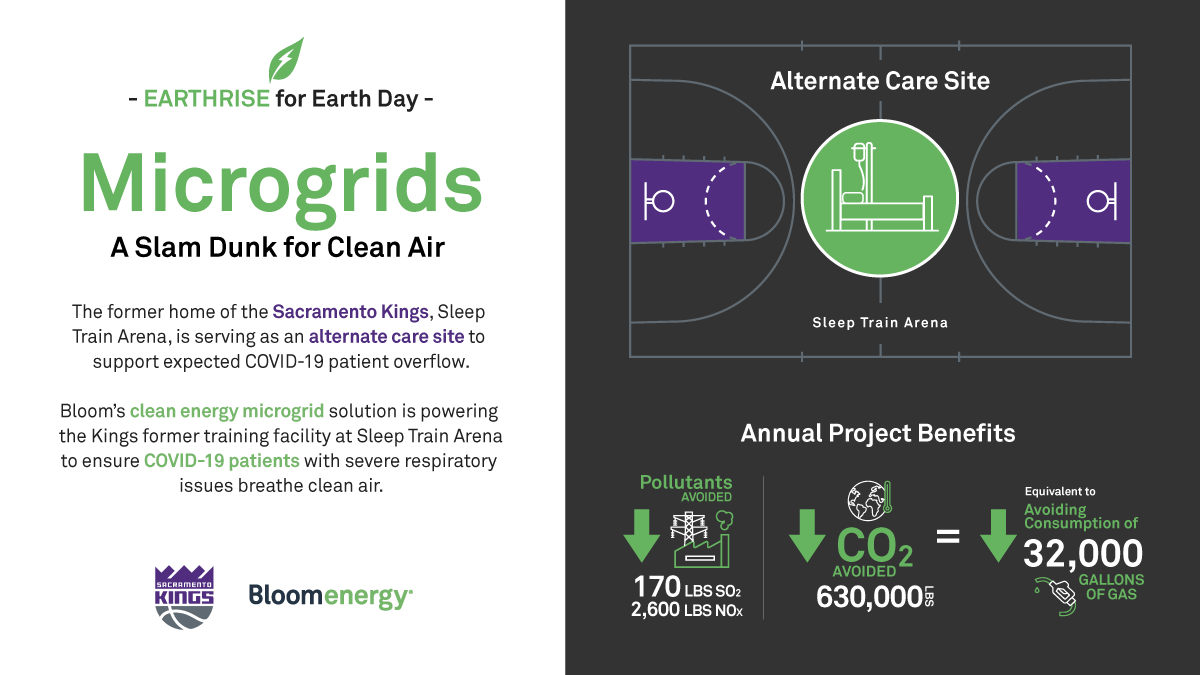
Beyond our rapid-deploy solution for COVID-19 field hospitals, we’ve been providing clean power for businesses and communities for nearly a decade. In fact, since we began commercial deployments in 2011, our Energy Servers have reduced more than 5 million pounds of SOx and 9 million pounds of NOx.

Read more about how Bloom reduces emissions
Creating a clean air future that lasts
Sustaining the improved state of our air after global lockdowns are eased and economies are back in full swing may not be easy. But, at least we’ll know where to start.
Energy-related fuel combustion accounts for a large portion of global air pollution. Together, with biomass burning in low-income countries, it’s responsible for 85 percent of airborne respirable particulate pollution and almost all SO2 and NOx emissions to the atmosphere.
By investing in technologies that generate energy without fuel combustion – like fuel cells, solar panels, and wind turbines – we can safeguard the progress we’ve made.
With non-combustion power sources deployed around the world, we have a fighting chance at keeping our skies clean and clear, free of smog. And, clean air is more important than ever as we continue the battle against COVID-19.
Learn more about Bloom’s commitment to fighting the coronavirus pandemic
Join us in standing up for clean air
On the 50th anniversary of Earth Day, we hope to raise awareness about the dangers of poor air quality and unite organizations and communities for the advocacy of environmental protection – particularly, the state of our air.
As members of the global community, we all have an opportunity to be a part of the solution. Let’s work together to drive better choices on the ground to ensure better health of our skies.
#TogetherWeCan #BeTheSolution
 Stephen Lamm leads Bloom’s sustainability initiatives and supports business development efforts across the company’s decarbonized product portfolio. He’s spent 15 years working in corporate sustainability, environmental markets, and green finance.
Stephen Lamm leads Bloom’s sustainability initiatives and supports business development efforts across the company’s decarbonized product portfolio. He’s spent 15 years working in corporate sustainability, environmental markets, and green finance.

